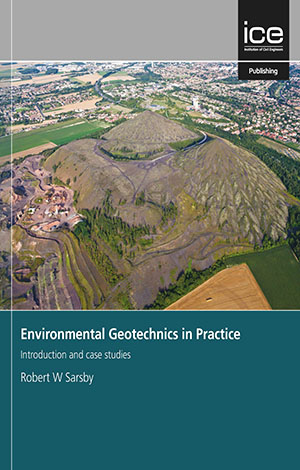Environmental Geotechnics in Practice: Introduction and case studies
Environmental Geotechnics in Practice is an informative and practical guide to the study of land-based waste disposal. The book identifies the key elements of a variety of waste disposal systems, and explains their role in protecting the environment. Using the most significant case histories from across the world where key lessons have been learned the book provides an engaging introduction to this important field.
The cases described all concern land-based waste disposal sites where there is significant interaction between ground engineering and the environment. Together they demonstrate that whatever the type of waste being disposed of it is possible to use geotechnical principles and practices to design a suitable facility. The author explains how the lessons from these historical cases can help current designers and constructers of waste disposal facilities to address the problems posed by climate change and land shortage. The book provides a broad coverage of environmental geotechnics relating to the performance of landfill sites, treatment of contaminated and damaged land, and stability of waste dumps (tips, tailings and lagoons).
Environmental Geotechnics in Practice will encourage readers to critically appraise the applicability of any design concept and data for the whole lifetime of a waste disposal project. The book will be of interest to a wide readership including professionals working in geotechnical engineering, environmental scientists, geology, and waste management, and also students of these subject areas.
Meet the author and read his blog, Land-based waste disposal: What's in your backyard and who's checking that it's safe?
Case histories in the book include:
Landfilling: Drigg (UK); Army Creek (USA); Loscoe (UK); Kettleman Hills (USA); Gin Hall (UK); North Shields (UK); Closed sites: Australia, Spain, UK, USA; Composites: Canada, USA; Puente Hills (USA)
Contaminated and damaged land: Lekkerkerk (The Netherlands); Bathgate (UK); Love canal (USA); Bishop Auckland (UK); Combe Down (UK); Tennants mine (Northern Ireland); Brzeg airfield (Poland); Pride Park (UK); Greenwich peninsula (UK)
Waste dumps: Jupille (Belgium); El Cobre (Chile); Aberfan (UK); Buffalo Creek (USA); Stava (Italy); Deighton (UK); Channel tunnel (France, UK); Kolontar (Hungary); Mount Polley (Canada)
Book Reviews
The book is a useful compendium of topics in environmental geotechnics, based on a wide range of case studies from around the world. The author has resisted the temptation to go into too much detail, but the mechanisms of failure or behaviour are clearly and concisely explained. Environmental geotechnics is now an established branch of the discipline of ground engineering, thanks, in part, to the author’s contribution over the past two or three decades. This book neatly charts its history, and provides an interesting and practical snapshot of its current state of development. To anyone running or developing a master’s level course in environmental geotechnics, this book would be a valuable core text and resource.
William Powrie, Professor of Geotechnical Engineering, University of Southampton
This is environmental geotechnics in practice focused on over 25 case histories, each meticulously analysed to identify key issues. A superbly referenced book of real world experience; essential reading for those who wish to learn from the history of environmental geotechnics and look to its future.
Stephan Jefferis, Director Environmental Geotechnics Ltd
An excellent compilation of a wide variety of case histories in the geoenvironmental arena, including landfills, waste disposal sites, mine tailing dams, contaminated lands, and more. The well documented case histories from Europe, America and Asia include failures, successes, and innovative solutions. There is an introductory chapter and a concluding chapter, but clearly the case histories and excellent references are the major contributions of the book.
Thomas F Zimmie, PhD, P.E., D.GE, Professor of Civil and Environmental Engineering, Rensselaer Polytechnic Institute
In Environmental Geotechnics, Bob Sarsby has assembled a valuable introduction to the management of landfills, contaminated land and waste dumps. Here, in one source location, through 27 carefully researched case studies, is a principled and practical guide to past successes and failures of waste management storage facilities and their consequences. Bob Sarsby has an impressive record of association with the subject of environmental geotechnics, having authored an earlier textbook and led the GREEN series of conferences on the topic. Here, Bob combines an insightful and accessible review of relevant soil mechanics with more detailed case study site investigation data. The balance Bob has struck between theory and observation will find favour with a wide audience – from geotechnical engineers approaching contaminated land remediation projects or landfill containment design for the first time, to environmental engineers, typically stronger on the geochemistry, but who are keen to recognise the overarching influence of mechanical stability. Regulators and problem holders will also benefit from its perspetive. Whilst there is no shortage of indicative references to environmental chemistry, practical guides to implementation are in shorter supply. Environmental Geotechnics in Practice fills that gap.
Dr John McDougall, School of Engineering & Built Environment, Edinburgh Napier University
This book is useful and informative – it should appeal to a wide variety of readers interested in ground engineering at any stage in their career. The introduction carefully sets the scene, but the strength of the book is in the well-researched case studies. These studies (from Europe, America and Asia) cover the environmental geotechnics relating to the performance of landfill sites, the treatment of brownfield sites and the stability of waste in lagoons, tailings and tips. The book successfully explains the mechanisms of failure, or success, of the various case studies without going into excessive detail. For further detail a reader can use the excellent set of references.
The author states that the book is “intended to be of benefit to persons working in industries where there is significant interaction with the ground who wish to refresh or augment their knowledge”. I believe that he has achieved his aim.
Nick Gorst, independent consultant


No customer reviews